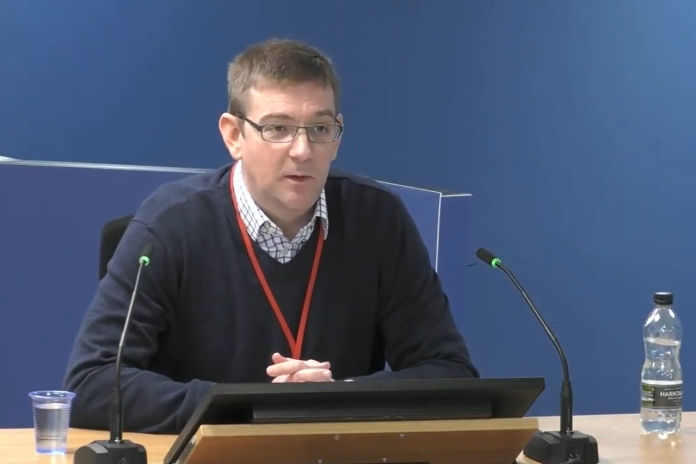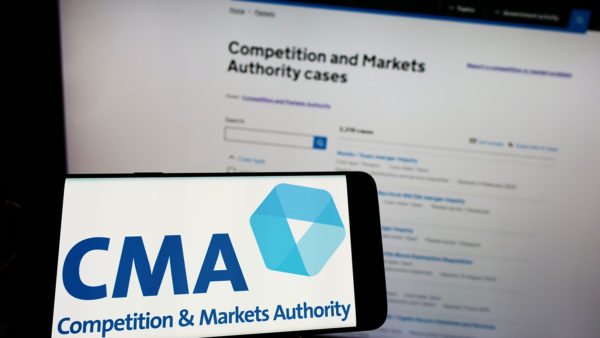
A former Celotex employee was aware that his colleagues were attempting to create a “misleading” test report for the combustible Celotex RS5000 insulation used in Grenfell Tower, as part of a bid to market it as suitable for use in buildings above 18m, but did not raise concerns because of a “failure of courage”.
Jamie Hayes started working for Celotex in a temporary administrative role in 2004 before becoming a technical services officer. Despite the role’s title, Hayes did not have any technical qualifications and described the role as a customer support role within the marketing team where he would answer questions about the suitability of products for a particular application, as well as calculating U-values. He offered technical support to product manager Jonathan Roper in his efforts to launch RS5000 as a product suitable for buildings above 18m.
Hayes was asked about a BRE report produced after the second, successful BS 8414 test of RS5000, which omitted details of the 6mm magnesium oxide board placed adjacent to the fire barrier to help it pass. The detail was also omitted from a draft report.
Hayes asserted that the decision was made by Celotex that the presence of the magnesium oxide would not be referred to in the report.
Lead counsel to the Inquiry Richard Millett QC asked Hayes if, given that the presence of the material wasn’t identified in the BRE’s draft report, it meant Celotex had made a decision not to correct the draft so as to provide a complete description of the system, or if he thought there had been prior agreement that the draft shouldn’t contain reference to the magnesium oxide.
Hayes replied: “Well, the short answer is: I don’t know.”
He added that he could not recall any discussions he had had with the BRE’s Phil Clark or anyone else from that organisation about the omission of the 6mm magnesium oxide board or the 8mm of Marley Eternit cladding that covered it.
But Hayes suggested that Clark would have known the detail had been omitted because Celotex had asked him to remove a photo from the report which showed the magnesium oxide.
In a 1 July 2014 email, attached to the first draft of the test report dated 2 June 2014, Celotex product manager Jon Roper asked Clark: “Could you also replace figure 18 with the attached photographs as we want to show a close-up of the condition of our insulation below and above fire break with the intumescent fired off.” The email copied in Celotex head of marketing Paul Evans, as well as Hayes himself.
Millett asked: “Now, when you saw this email did you understand that Jon Roper was asking the BRE to remove what, on the face of the report, was the only element of the report which showed the presence of the magnesium oxide layer?”
Hayes replied: “Yes, I did.”
Asked about the background of the request, Hayes said: “My memory isn’t brilliant, but I have a memory of being upstairs in possibly Jon’s office and Paul Evans was there, they were discussing the photograph and the reasons for the removal of that photograph, and I think it was because it clearly showed the missing material which they didn’t want to appear in the report, and that the purpose of asking Phil to remove that photograph was for no other reason than to remove a photograph which was, I think, a dead giveaway, if you like, that that missing material was on the test rig.”
Hayes said he did not have a separate discussion with either Roper or Evans about the request but that it was clear from the email that Evans was aware of it.
Hayes said: “I think he absolutely knew exactly what that was, and I would imagine that it would have been — well , I don’t know, and I don’t want to, again, say things that I don’t know, but my understanding and everything of how Paul had been the ultimate decision-maker up until then, that would lead me to believe that he would have asked Jon to do that. And again, there’s absolutely no doubt in my mind, based upon that conversation which I witnessed, that Paul was completely aware of the reason for that photograph being asked to be removed, and I think it’s most likely that actually he had asked Jon to do that.”
In his evidence earlier this week, Evans denied being aware of the presence of magnesium oxide in the test rig until 2017.
In his evidence on Monday (16 November), Roper said he was “fully aware” that the rig was being “overengineered to achieve a pass” and that he had altered presentation slides about RS5000’s successful test to remove references to magnesium oxide at Evans’s request.
Millett asked Hayes: “Was it your view or understanding at the time that Celotex was engaged in a deliberate attempt to create a misleading test report?”
Hayes replied: “Yes. That’s exactly what was happening.”
Millett asked: “Were you concerned about that?”
Hayes responded: “I was very concerned about that.”
Asked why he did not challenge it, he said: “It’s not an easy question to answer. My understanding was, and now, is that a decision had been made by the senior management of Celotex. I didn’t know who I should speak to or who I could speak to. I lacked, I guess, the life experience to find the right way forward, and it was a failure of courage and a failure of character and a failure of moral fibre on my part not to do so.”
Second test arranged “incredibly quickly”
Hayes also told the Inquiry that he saw the rapid arrangement of a second test for RS5000 in May 2014, after it failed in February 2014, as an indication of the pressure the company was under to develop new products.
Hayes agreed that Celotex became more marketing-driven after the business was acquired by Saint-Gobain in 2012 and that there was increased pressure to develop new products.
While he did not feel personal pressure to do his role differently, Hayes said he saw pressure on others, for example as part of the “18m project”.
He told the Inquiry: “After the first 18m test failed, a second test was arranged incredibly quickly and although it didn’t seem strange to me at the time, I look back on that now and think it’s almost unbelievable that I think only a few months passed between the failure of a major test and how quickly a second test was arranged, authorised, paid for, and not to mention the fact that…you would have top actually build a rig, which is to say have all the materials, have someone construct it….How quickly they turned around between 1 to 2 I think illustrates quite well that they were not prepared to wait any longer than was humanly possible to progress that project and I guess the ultimate goal of that project was to have a product which could be sold to increase profits.”
In an opening statement given by Celotex at the start of module 2 of phase 2 of the Inquiry, it said: “Celotex recognises that the matters which emerged during its investigations involved inappropriate and unacceptable conduct on the part of a number of employees. This was of real concern to Celotex’s current management. Some of the employees involved had already left the company. Those who remained were the subject of disciplinary proceedings. Six employees resigned between December 2017 and March 2018.”
Samantha Leek QC, counsel for the BRE, said in her opening statement that the testing house had “no involvement” in assessing the safety of cladding systems installed on the tower.
Leek said: “BRE is not a regulator and does not fulfil the function of a building control authority. It has no mandate, role or authority to monitor what manufacturers and suppliers do with their test and classification reports, and has no oversight as to how they are used to fulfil their obligations under Building Regulations. BRE’s function is that of a test house; in short, to burn systems and products and assess how they perform.”
The Inquiry continues.









